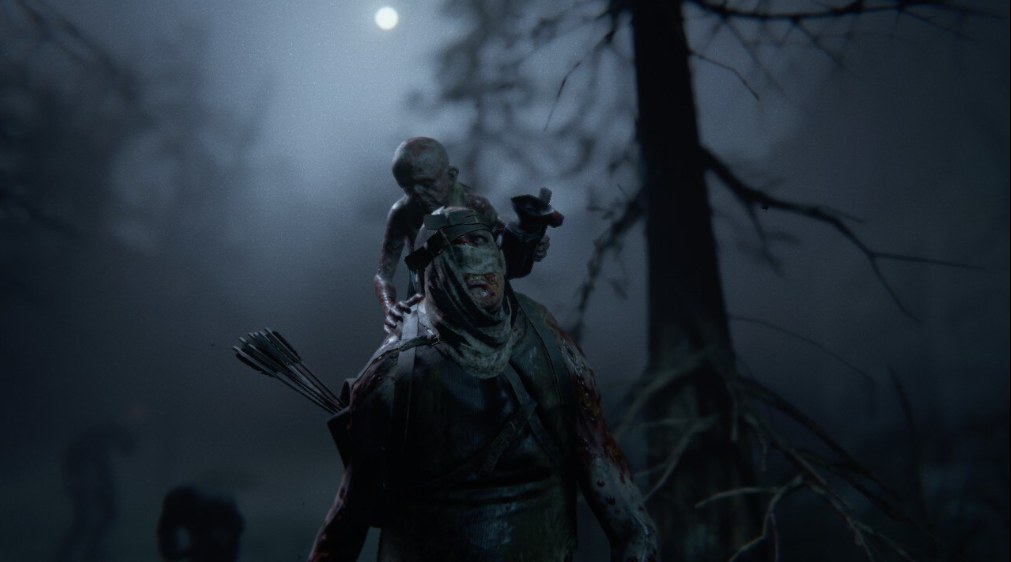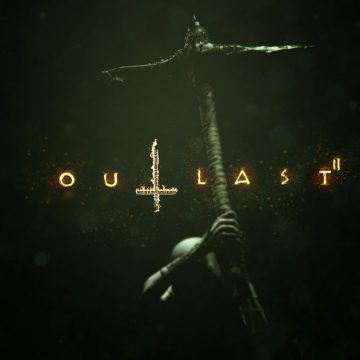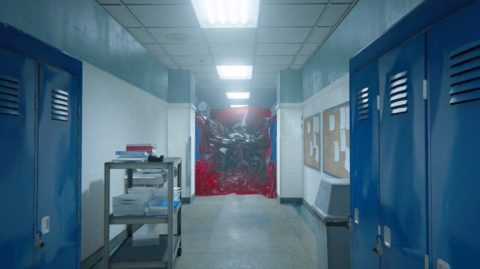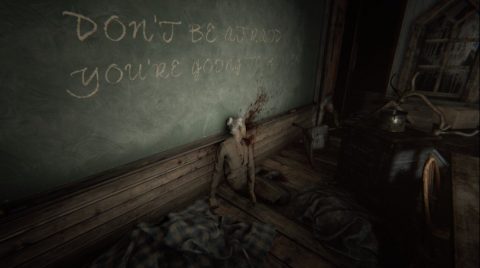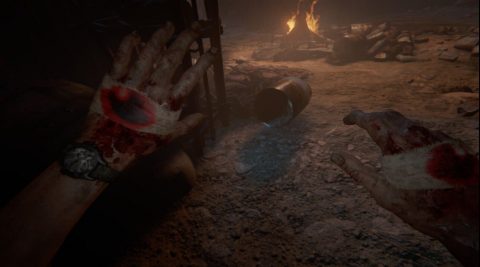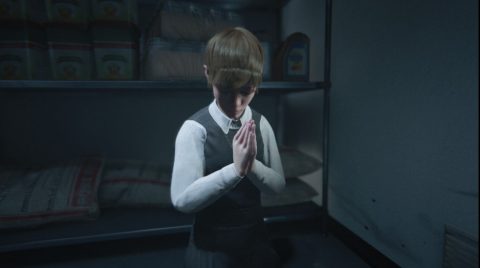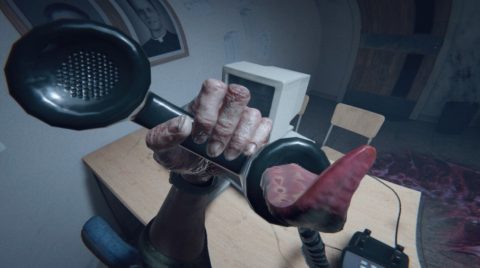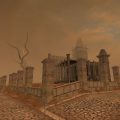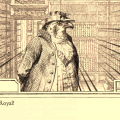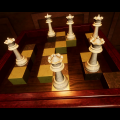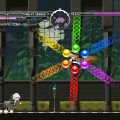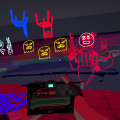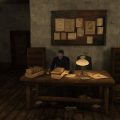- Outlast
- Outlast: Whistleblower
- Outlast 2
If there’s one thing that can be said for Outlast 2, it’s definitely ambitious. The original game created tense horror using the claustrophobic environment of Mount Massive Asylum. Outlast 2 takes place in a remote Arizona village with many more open-ended locations. In Outlast, the story is gradually revealed to the protagonist and the player, and by the end, both have a decently complete idea of what has transpired. Outlast 2 is much more ambiguous, to the point where huge elements of the plot are either implied, or left unexplained entirely. Outlast: Whistleblower built upon the foundations of the original game, adding more depth to the existing setting. Outlast 2 is – except for a single, easily-missed document found a little over halfway through the game – entirely disconnected from the established plot. None of these ideas are inherently bad, but they certainlyaren’t implemented well in Outlast 2.
Following the success of Outlast in 2013, Red Barrels officially announced that a sequel was in development in October 2014, just five months after the release of the DLC Outlast: Whistleblower. Red Barrels co-founder, Philippe Morin, was quick to confirm that it would feature different characters in a different setting, with little to no connection to the first game. With the runaway success of Outlast under their belts, it’s easy to forget that Red Barrels were still a very new company, formed in 2011 and with only around twenty-five staff at the time that Outlast IIbegan being developed.
Released in April 2017, Outlast 2 opens with protagonist Blake Langermann having a brief auditory nightmare foreshadowing a vague but predictable childhood trauma. Blake – a cameraman – wakes up on a helicopter with his wife, Lynn – an investigative journalist – and skirting around the question of how he managed to fall asleep on a helicopter, they rehearse their lines for the story Lynn is presenting; an anonymous young pregnant woman was found wandering barefoot on a barren stretch of highway hundreds of miles from the nearest city, and died shortly afterwards. Murder is suspected, but not confirmed – as Blake and Lynn briefly argue over what wording should be used – and their search has brought them to Supai, Arizona. One unexplained flash of booming light and a crash-land later, Blake regains consciousness in the wreckage and finds Lynn missing and their pilot skinned alive, which he correctly assumes did not happen in the crash. So begins Blake’s journey through Temple Gate, a dilapidated and hitherto unknown community of religious fanatics who are convinced that the end is nigh.
The gameplay in Outlast 2 is much the same as it was in the original, with a few notable additions. Like previous protagonists, Blake has no means of fighting back, so any encounter with a hostile individual is met with the choice to run, hide or die. Blake’s trusty camcorder has the same night-vision function, which still drains your battery at an alarming rate, but now also comes with sound detection, for moments when you want to know approximately where the mutterings of your nearest deranged stalker are coming from. Blake also no longer gradually regenerates health, so on top of managing batteries for your camcorder, you need to make sure you have a few bandages on hand in case you take a nasty hit. There’s also an unexpected but welcome gameplay shift around halfway through the game in which Blake spends ten minutes rafting to his next destination, and while there are still enough jump-scares to keep you on your toes, it’s understated, isolated, and absolutely fantastic.
Another returning feature from the original game is an excellent soundtrack by Samuel Laflamme. The chase sequences are just as frantic, hiding from pursuers is just as tense and paranoid, and they all have a rural edge that fits the setting perfectly; Samuel even created an instrument himself out of metal string and a piece of wood that is present throughout the score. These helped the sequel retain the immersive atmosphere that made the original titles so gripping; whether it’s the shrill wails of Marta’s chase theme, or the twisted ambience of the mines, complete with the distant echoes of cultlike chanting, the soundtrack of Outlast 2 consistently enhances the tension.
The voice-acting is phenomenal, but limited by the narrow scope of each character. Shawn Baichoo does a fantastic job portraying Blake’s fear, panic and confusion, but he never gets the chance to try anything else. Vlasta Vrana perfectly captures the sleazy, hypocritical fanaticism of Temple Gate’s leader, Sullivan Knoth, who you hear across loudspeakers all over the settlement, but he only appears in person twice in the entire game, and while the other villains are decent enough, none of them have the affable charm of Dr Trager, the horrifying obsession of Eddie Gluskin, or the relentless persistence of Chris Walker from the earlier games.
Every Outlast game has interesting villains, but Outlast 2 doesn’t utilize them very well. Marta is Knoth’s right-hand woman and most devoted follower, and while she can normally be found muttering verses from the Gospel of Knoth to herself in an unsettling husky voice, upon spotting Blake, she is more than happy to shriek like a banshee and charge him at incredible speed, hoping to introduce him to her favourite rosary-adorned pickaxe. But she only appears in the first third or so of the game, before making a brief reappearance at the end. Laird and Nick, a sadistic dwarf and his mentally simple but superhumanly strong servant (and steed) are the leaders of the Scalled, a subset of Knoth’s group who have shunned modern medicine – with predictable results – and they get more focus than any other villain in the game, but this is only because they feature in not one, but two extended cutscenes in which they capture Blake and put him through some uncomfortable physical trauma, as if the developers were under the impression that since the previous titles only featured one capture/torture sequence, this must make the sequel twice as good.
A decent summary of the failure to capitalize on the uniqueness of the villains is found in the primary conflict between Knoth’s followers – the Testament of the New Ezekiel – who believe that Lynn is pregnant with the Antichrist, and the heretics, a splinter faction of former New Ezekiel followers, who concur, but affirm that the birth of the Antichrist would be a good thing. Blake has to avoid Knoth’s followers because they wish to capture Lynn and kill Blake, whereas he has a difficult time dealing with the heretics because their intentions are to kill Blake and capture Lynn. This brings us to the greatest problem in Outlast 2, that being that the story simply isn’t very good.
Outlast 2 is brimming with themes and imagery, but there’s no substance or meaning behind any of it. The story was largely based on the Jonestown massacre of 1978, but other than reminding the player that this was a scary thing that happened, it isn’t explored in any depth or portrayed in a new or interesting way; ditto for the extensive religious themes. And the developers don’t have to try to explore these themes, but given how self-serious, humourless and bleak the experience is from start to finish, it’s very clear that they’re trying to. If Outlast is a camp, stupid but self-aware and gore-laden throwback to the grindhouse era, Outlast 2 is more of the same, but the tone is a complete mismatch; it’s like if someone directed Sharknado 4, but under the impression that they were makingCitizen Kane. Or to stick to video games, it’s like if the developers of a mobile Five Nights At Freddy’s spin-off treated the project as if they were working on Silent Hill 2.
There is one religious theme present in the story that deserves to be covered seriously, but it’s handled so clumsily and unoriginally that it would be better if Red Barrels hadn’t bothered.Around a quarter of the game takes place in hallucinations in which Blake finds himself reliving a traumatic experience from his Catholic elementary school days. This experience involved a friend of his named Jessica, and it left him with severe feelings of guilt that continue to this day. Without disclosing anything more, the situation – as it is gradually revealed via flashbacks laden with bluntly obvious foreshadowing – is exactly what most people will immediately assume that it is, and not in a subversive or interesting way. It also has absolutely nothing to do with the rest of the story, other than letting us know that Blake has a traumatic past along with the traumatic present that he is currently experiencing.
And it certainly is a traumatic present; over the first half of the game, Blake is assaulted repeatedly, injured, vomited on, crucified, buried alive and more, all while being forced to relive his worst memories. It would be an understatement to say that this is unpleasant, but it isn’t even effective horror, as the slew of horrible things you see quickly becomes more tiresome than terrifying. Good horror is subtle and gets under your skin; one of the most genuinely unsettling moments in the game is when Blake traverses a chapel that doubled as a schoolhouse, and written on the chalkboard in huge letters is “DON’T BE AFRAID, YOU ARE GOING TO HEAVEN”. After recording this, there’s a cheap jump-scare in which all of the school desks fly open, but it’s still an unnerving reminder that the cultists of Temple Gate were dangerous long before they started chasing you around with machetes. But this moment is unlikely to scare you, because just ten minutes into the game, Blake has to take a shortcut through a mass-grave of murdered children, and it’s difficult to build tension when that is your starting point.
Blake himself does the game no favours, as despite being much more vocal than the previous protagonists Miles Upshur and Waylon Park – who were silent, save for a few grunts – Blake exhibits a shocking lack of personality. Through Miles’ notes, gained by recording important events or certain parts of the scenery, you could view the journey as his desperation to escape is gradually whittled down by the reluctant drive to uncover what is going on at Mount Massive Asylum. Waylon, knowing what is happening from the start, contrasts this with a horrified innocence and steadfast determination to return to his family. Blake doesn’t make a single recording in the game with commentary that could not be summed up with “I am afraid,” or “Crikey, this is all a bit messed up, isn’t it?” and he concludes the story in the same manner as the player; exactly as he started it, without having accomplished anything and with no clue what is going on.
A lot of people were unsatisfied that Outlast 2 had little to no connection to previous Outlast titles, but a connection wouldn’t have been necessary as long as the new and original plot was engaging on its own merits, and unfortunately it isn’t. Outlast 2 is essentially a series of setpieces in which very bad things happen while even worse things are alluded to, while Blake – and by extension, the player – happens to be present, without ever really affecting anything. The rise and fall of the villains you encounter happen in unlikely coincidences or unrelated events that Blake has no bearing on, leaving the player with the sense that they’re just a passenger on this very off-putting journey. Red Barrels would be wise to remember that a game that is intentionally unpleasant to play is still unpleasant to play, and while a founding principle of the horror genre is to make your audience uncomfortable, this alone isn’t enough to guarantee success. Or in some cases, adequacy.
Outlast 2 is not a disaster, but it’s definitely a misstep. A prequel to the series, The Outlast Trialswas released in early access in Spring 2023 to positive reception – returning to the scope of over-the-top camp horror that the original game is loved for – and it would be dishonest to act as though the general reception to Outlast 2 was considerably worse than the original. There’s still a lot to enjoy in Outlast 2 – the chilling atmosphere, the brilliant soundtrack, and the core gameplay from the original is as tense and exciting as ever – but it’s let down by an ambitious story that’s sorely lacking in substance.
